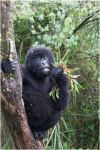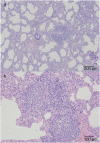Mountain gorilla lymphocryptovirus has Epstein-Barr virus-like epidemiology and pathology in infants
- PMID: 28706209
- PMCID: PMC5509654
- DOI: 10.1038/s41598-017-04877-1
Mountain gorilla lymphocryptovirus has Epstein-Barr virus-like epidemiology and pathology in infants
Abstract
Epstein-Barr virus (EBV) infects greater than 90% of humans, is recognized as a significant comorbidity with HIV/AIDS, and is an etiologic agent for some human cancers. The critically endangered mountain gorilla population was suspected of infection with an EBV-like virus based on serology and infant histopathology similar to pulmonary reactive lymphoid hyperplasia (PRLH), a condition associated with EBV in HIV-infected children. To further examine the presence of EBV or an EBV-like virus in mountain gorillas, we conducted the first population-wide survey of oral samples for an EBV-like virus in a nonhuman great ape. We discovered that mountain gorillas are widely infected (n = 143/332) with a specific strain of lymphocryptovirus 1 (GbbLCV-1). Fifty-two percent of infant mountain gorillas were orally shedding GbbLCV-1, suggesting primary infection during this stage of life, similar to what is seen in humans in less developed countries. We then identified GbbLCV-1 in post-mortem infant lung tissues demonstrating histopathological lesions consistent with PRLH, suggesting primary infection with GbbLCV-1 is associated with PRLH in infants. Together, our findings demonstrate that mountain gorilla's infection with GbbLCV-1 could provide valuable information for human disease in a natural great ape setting and have potential conservation implications in this critically endangered species.
Conflict of interest statement
The authors declare that they have no competing interests.
Figures


References
-
- De-Thé, G. Epidemiology of Epstein-Barr virus and associated diseases in man in The Herpesviruses (ed. Roizman, B,) 25–103 (Plenum Publishing Corp., 1982).
-
- Shimakage M, Sakamoto H, Harada S, Sasagawa T, Kodama K. Expression of the Epstein-Barr virus in lymphoproliferative diseases of the lung. Oncol. Rep. 2007;17:1347–52. - PubMed
Publication types
MeSH terms
Grants and funding
LinkOut - more resources
Full Text Sources
Other Literature Sources
Research Materials
Miscellaneous

